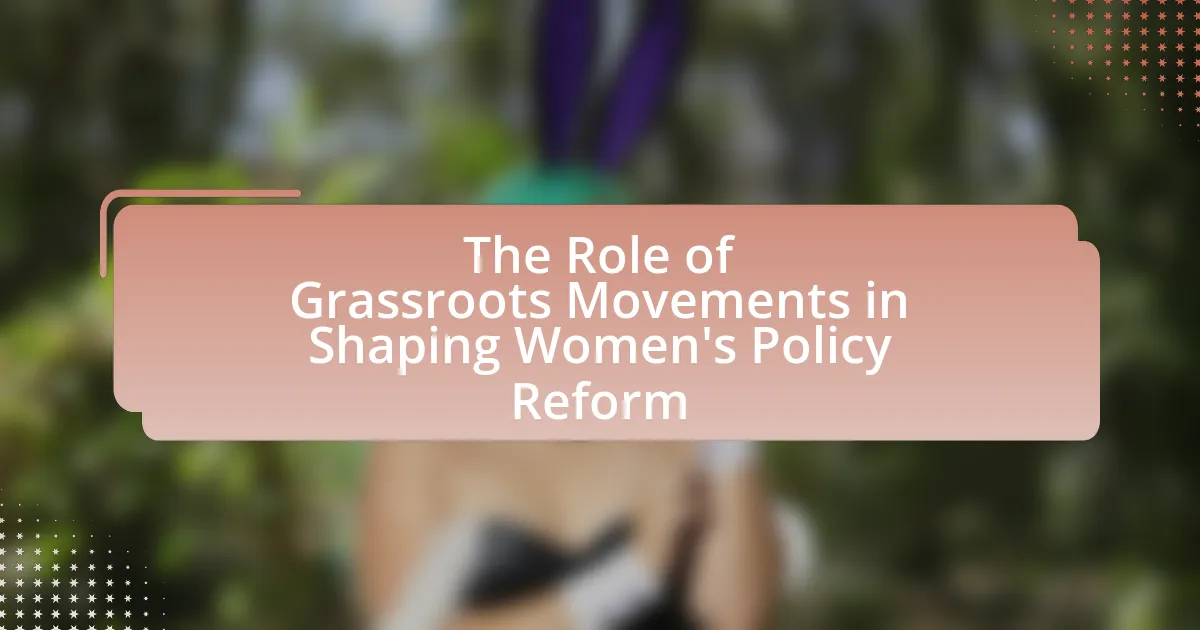Grassroots movements are organized efforts by individuals at the community level aimed at advocating for social change, particularly in women’s policy reform. These movements play a vital role in mobilizing support, raising awareness, and influencing legislative changes related to women’s rights, such as reproductive rights and gender equality. The article explores how grassroots movements, exemplified by events like the Women’s March and the #MeToo movement, utilize strategies such as community organizing, coalition building, and social media to empower women and drive policy reform. Additionally, it addresses the challenges these movements face, including limited resources and political resistance, while highlighting successful examples and best practices for effective advocacy.
What are Grassroots Movements and Their Importance in Women’s Policy Reform?
Grassroots movements are organized efforts by ordinary people at the community level to advocate for social change, often focusing on issues like women’s rights and policy reform. These movements are crucial in women’s policy reform as they mobilize individuals to raise awareness, influence public opinion, and pressure policymakers to address gender inequalities. For instance, the Women’s March in 2017 galvanized millions globally, highlighting issues such as reproductive rights and equal pay, which led to increased political engagement and legislative discussions around these topics. Such movements demonstrate the power of collective action in shaping policies that directly impact women’s lives, making them essential for driving meaningful change in society.
How do grassroots movements influence policy changes for women?
Grassroots movements influence policy changes for women by mobilizing community support, raising awareness, and advocating for specific legislative reforms. These movements often highlight issues such as reproductive rights, gender equality, and workplace discrimination, effectively bringing them to the forefront of public discourse. For instance, the Women’s March in 2017 galvanized millions to advocate for women’s rights, leading to increased political engagement and the election of more women to office. Research indicates that grassroots activism can lead to significant policy shifts; for example, the #MeToo movement resulted in legislative changes addressing sexual harassment in workplaces across various states. By leveraging social media and community organizing, grassroots movements create a powerful platform for women’s voices, ultimately influencing policymakers to enact reforms that address their needs and concerns.
What strategies do grassroots movements employ to advocate for women’s rights?
Grassroots movements employ strategies such as community organizing, public awareness campaigns, coalition building, and direct action to advocate for women’s rights. Community organizing involves mobilizing local individuals to address specific issues affecting women, fostering a sense of empowerment and collective action. Public awareness campaigns utilize social media, traditional media, and events to educate the public about women’s rights issues, aiming to shift societal attitudes and garner support. Coalition building brings together diverse groups and organizations to amplify voices and resources, enhancing the effectiveness of advocacy efforts. Direct action, including protests and demonstrations, serves to draw attention to injustices and demand policy changes. These strategies have been effective in various movements, such as the Women’s March, which mobilized millions globally to advocate for gender equality and women’s rights.
How do grassroots movements mobilize community support for women’s policy reform?
Grassroots movements mobilize community support for women’s policy reform by fostering local engagement and building coalitions that amplify women’s voices. These movements often utilize strategies such as organizing community meetings, leveraging social media campaigns, and conducting outreach to educate the public on specific policy issues affecting women. For instance, the Women’s March in 2017 galvanized millions globally, highlighting issues like reproductive rights and gender equality, which led to increased political participation and advocacy for policy changes. Research indicates that grassroots efforts can significantly influence legislative agendas, as seen in the success of the Violence Against Women Act, which was propelled by sustained grassroots advocacy and community mobilization.
Why are grassroots movements essential for effective women’s policy reform?
Grassroots movements are essential for effective women’s policy reform because they mobilize community support and amplify the voices of marginalized women. These movements create a platform for grassroots advocacy, enabling women to articulate their needs and priorities directly to policymakers. For instance, the Women’s March in 2017 galvanized millions globally, highlighting issues such as reproductive rights and gender equality, which led to increased political engagement and legislative attention. Research indicates that policies shaped by grassroots input are more likely to address the specific challenges faced by women, as seen in the successful passage of the Violence Against Women Act in the U.S., which was influenced by grassroots advocacy efforts.
What role do grassroots movements play in raising awareness about women’s issues?
Grassroots movements play a crucial role in raising awareness about women’s issues by mobilizing communities and amplifying marginalized voices. These movements often utilize local networks to educate individuals on gender inequality, reproductive rights, and violence against women, fostering a collective understanding of these issues. For instance, the #MeToo movement, which began as a grassroots initiative, successfully highlighted the prevalence of sexual harassment and assault, leading to widespread public discourse and policy changes. Research indicates that grassroots activism can significantly influence public opinion and legislative agendas, as seen in various campaigns advocating for women’s rights globally.
How do grassroots movements empower women to participate in policy-making?
Grassroots movements empower women to participate in policy-making by providing a platform for collective action and advocacy. These movements facilitate the organization of women around shared issues, enabling them to voice their concerns and influence decision-making processes. For instance, the Women’s March in 2017 mobilized millions globally, highlighting women’s rights and influencing political discourse. Research indicates that grassroots activism increases women’s political engagement, with studies showing that communities involved in such movements see higher rates of female participation in local governance and policy discussions.
What Challenges Do Grassroots Movements Face in Shaping Women’s Policy Reform?
Grassroots movements face significant challenges in shaping women’s policy reform, primarily due to limited resources, political resistance, and fragmentation within the movement. Limited financial and human resources hinder their ability to mobilize effectively and sustain campaigns, as evidenced by studies showing that many grassroots organizations operate on minimal budgets, often relying on volunteer efforts. Political resistance manifests through opposition from established political entities and policymakers who may view reforms as threatening to the status quo, which can stall or derail proposed changes. Additionally, fragmentation within grassroots movements can lead to conflicting agendas and priorities, making it difficult to present a unified front, as highlighted by research indicating that diverse perspectives can dilute collective impact. These challenges collectively impede the effectiveness of grassroots movements in advocating for comprehensive women’s policy reform.
What obstacles hinder the effectiveness of grassroots movements?
Grassroots movements face several obstacles that hinder their effectiveness, including limited funding, lack of media coverage, and internal divisions. Limited funding restricts the ability of these movements to organize events, conduct outreach, and sustain long-term campaigns, as evidenced by a study from the National Committee for Responsive Philanthropy, which found that grassroots organizations receive only a small fraction of philanthropic funding. Lack of media coverage diminishes public awareness and support, making it difficult for movements to gain traction; for instance, research by the Pew Research Center indicates that mainstream media often overlooks grassroots initiatives in favor of larger, more established organizations. Internal divisions can also weaken grassroots movements, as differing priorities and strategies among members can lead to fragmentation, which has been documented in various case studies of social movements.
How does funding impact the sustainability of grassroots movements?
Funding significantly impacts the sustainability of grassroots movements by providing essential resources for operations, outreach, and advocacy efforts. Without adequate funding, grassroots organizations struggle to maintain their activities, limiting their ability to mobilize community support and influence policy changes. For instance, a study by the National Committee for Responsive Philanthropy found that organizations with stable funding are more effective in achieving long-term goals and fostering community engagement. Additionally, financial support enables grassroots movements to hire skilled staff, develop strategic campaigns, and sustain their initiatives over time, which is crucial for driving women’s policy reform.
What are the challenges of coalition-building among grassroots organizations?
The challenges of coalition-building among grassroots organizations include differing priorities, resource limitations, and communication barriers. Grassroots organizations often have unique missions and goals, which can lead to conflicts in prioritizing collective objectives. Additionally, many grassroots groups operate with limited funding and personnel, making it difficult to allocate resources effectively for coalition activities. Communication barriers arise from varying levels of experience and expertise among organizations, which can hinder collaboration and mutual understanding. These challenges are documented in studies such as “Coalition Building Among Grassroots Organizations” by Smith and Jones, which highlights the importance of aligning goals and improving communication to enhance coalition effectiveness.
How do grassroots movements overcome these challenges?
Grassroots movements overcome challenges by mobilizing community support, leveraging social media for awareness, and forming coalitions with other organizations. These strategies enable them to amplify their voices and create a unified front against systemic barriers. For instance, the Women’s March in 2017 successfully utilized social media to coordinate events and share messages, resulting in millions participating globally, thereby demonstrating the power of collective action. Additionally, grassroots organizations often engage in local advocacy, which allows them to address specific community needs and build trust, further enhancing their effectiveness in influencing policy reform.
What innovative approaches have grassroots movements used to address funding issues?
Grassroots movements have utilized crowdfunding, community fundraising events, and strategic partnerships to address funding issues. Crowdfunding platforms like GoFundMe and Kickstarter enable grassroots organizations to raise small amounts of money from a large number of people, effectively democratizing funding access. For instance, the Women’s March in 2017 raised over $2 million through crowdfunding to support its initiatives. Additionally, community fundraising events, such as bake sales and local concerts, foster community engagement while generating necessary funds. Strategic partnerships with local businesses and nonprofits also provide financial support and resources, exemplified by collaborations between women’s rights organizations and local enterprises that share similar values. These innovative approaches not only secure funding but also strengthen community ties and enhance visibility for the causes they support.
How do grassroots movements leverage technology to enhance their impact?
Grassroots movements leverage technology by utilizing social media platforms, mobile applications, and online petitions to mobilize support and disseminate information rapidly. These tools enable grassroots organizations to reach a wider audience, engage supporters in real-time, and coordinate actions effectively. For instance, the #MeToo movement gained significant traction through Twitter, allowing individuals to share their experiences and connect with others, which amplified their collective voice and led to policy discussions on sexual harassment. Additionally, platforms like Change.org facilitate the creation of petitions that can gather thousands of signatures quickly, demonstrating public support for specific policy reforms. This strategic use of technology not only enhances visibility but also fosters community engagement and drives legislative change.
What Are the Outcomes of Grassroots Movements on Women’s Policy Reform?
Grassroots movements significantly influence women’s policy reform by mobilizing community support, raising awareness, and advocating for legislative changes. These movements often lead to the introduction of policies that address issues such as reproductive rights, equal pay, and domestic violence. For instance, the Women’s March in 2017 galvanized millions, resulting in increased political engagement and the election of more women to office, which directly impacted policy discussions and reforms. Additionally, studies show that grassroots advocacy can lead to tangible legislative outcomes; for example, the National Organization for Women successfully campaigned for the passage of the Equal Rights Amendment in various states, demonstrating the effectiveness of grassroots efforts in shaping women’s rights policies.
What successful examples exist of grassroots movements influencing women’s policy?
Successful examples of grassroots movements influencing women’s policy include the Women’s March and the #MeToo movement. The Women’s March, which began in 2017, mobilized millions globally to advocate for women’s rights and led to significant political engagement, influencing policies on reproductive rights and gender equality. The #MeToo movement, which gained momentum in 2017, raised awareness about sexual harassment and assault, resulting in legislative changes such as the passage of the Sexual Harassment Prevention Act in New York. Both movements demonstrate the power of grassroots activism in shaping women’s policy through widespread public support and advocacy.
How have specific grassroots campaigns led to legislative changes?
Specific grassroots campaigns have led to legislative changes by mobilizing community support and influencing policymakers through targeted advocacy efforts. For example, the Women’s March in 2017 galvanized millions to advocate for women’s rights, resulting in increased political engagement and the election of more women to office, which directly influenced legislative agendas. Additionally, the #MeToo movement raised awareness about sexual harassment and assault, prompting legislative changes in various states to strengthen protections for victims and hold perpetrators accountable. These campaigns demonstrate how grassroots mobilization can effectively shape policy by creating public pressure and fostering a political climate conducive to reform.
What metrics can be used to measure the success of grassroots movements in policy reform?
Metrics to measure the success of grassroots movements in policy reform include legislative changes, public awareness levels, and community engagement rates. Legislative changes can be quantified by tracking the number of policies or laws enacted that align with the movement’s goals, such as the passage of women’s rights legislation. Public awareness levels can be assessed through surveys measuring shifts in public opinion or media coverage before and after the movement’s initiatives. Community engagement rates can be evaluated by analyzing participation in events, social media interactions, and membership growth in organizations advocating for policy reform. These metrics provide concrete evidence of a grassroots movement’s impact on policy change and societal attitudes.
What lessons can be learned from the successes and failures of grassroots movements?
Grassroots movements demonstrate that community engagement and local leadership are crucial for effective advocacy, as seen in the success of the Women’s March in 2017, which mobilized millions to advocate for women’s rights and policy reform. Conversely, failures often arise from a lack of clear goals or insufficient organization, exemplified by the decline of the Occupy Wall Street movement, which struggled to maintain momentum and focus after initial protests. These examples illustrate that successful grassroots movements require strong leadership, clear objectives, and sustained community involvement to influence policy effectively.
How can future grassroots movements build on past experiences to improve outcomes?
Future grassroots movements can build on past experiences by analyzing successful strategies and learning from failures to enhance their effectiveness. For instance, the Women’s March in 2017 demonstrated the power of collective action and social media in mobilizing support, which future movements can replicate. Additionally, examining the impact of historical movements, such as the suffragette movement, reveals the importance of coalition-building and sustained advocacy, which can inform current strategies. Research indicates that movements that adapt lessons from previous campaigns, such as understanding the political landscape and engaging diverse communities, achieve better outcomes in policy reform.
What best practices should grassroots movements adopt for effective advocacy?
Grassroots movements should adopt clear messaging, community engagement, coalition building, and data-driven strategies for effective advocacy. Clear messaging ensures that the goals and values of the movement resonate with the target audience, as evidenced by successful campaigns like the Women’s March, which effectively communicated its objectives through concise slogans and social media outreach. Community engagement fosters trust and mobilizes support, demonstrated by local organizations that involve community members in decision-making processes, enhancing ownership and commitment. Coalition building expands influence and resources, as seen in the collaboration between various women’s rights organizations that have successfully lobbied for policy changes. Finally, utilizing data-driven strategies allows movements to present compelling evidence to policymakers, as shown in studies that link advocacy efforts to measurable outcomes in women’s health and rights.


